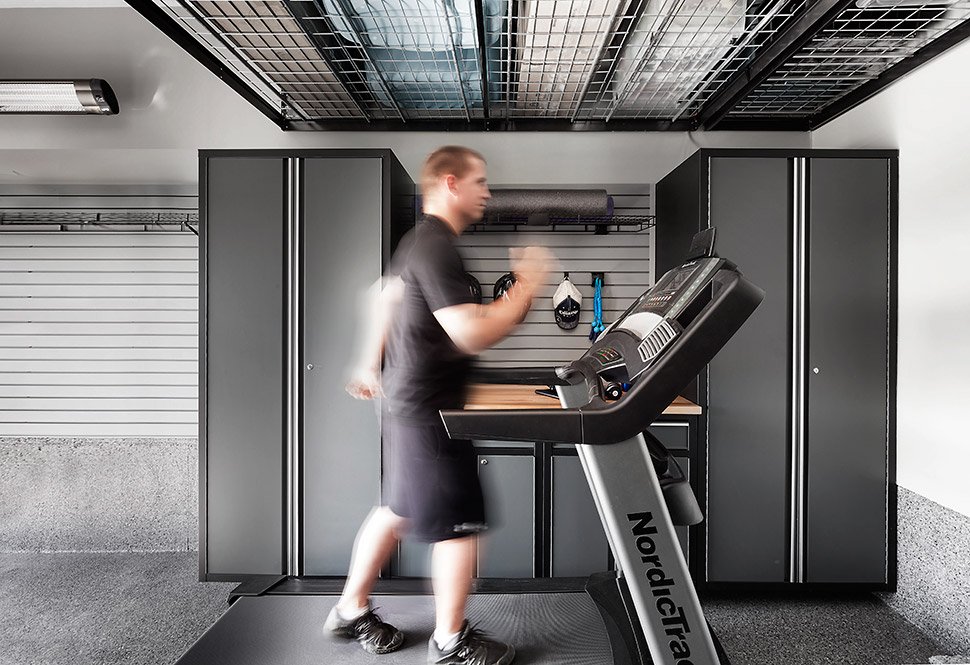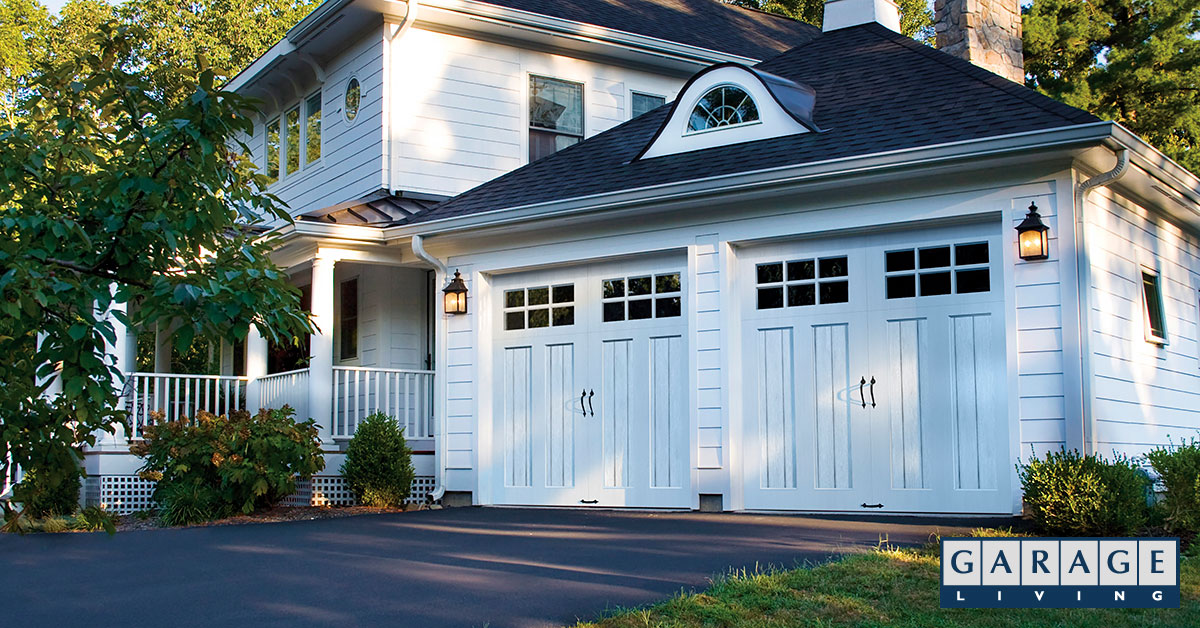Whether you live in a hot climate year-round or only experience high temperatures for a few months a year, a garage that’s excessively hot is never pleasant.
Who likes stepping out of their air conditioned vehicle into sauna-like temperatures inside their garage? And what if you regularly use the garage for exercising, as a workshop, or other hobbies?
Sweltering temperatures can really limit your enjoyment of garage activities and make it a room you avoid as much as possible during hot weather. So what garage cooling ideas work best?
Why does your garage get so hot?
Without air conditioning in your garage, its temperature can be as much as 10-18°F (5-10°C) warmer than the outside temperature.
Let’s first look at a few factors that can raise a garage’s temperature:
- garage location (west-facing houses are exposed to the sun’s more intense late afternoon heat)
- whether or not a garage is insulated
- the color of a garage’s door and exterior
- whether a garage has a ventilation system or dehumidifier
- a recently driven vehicle being parked in the garage
9 garage cooling ideas to beat the heat
Clearly, changing your garage’s location isn’t a feasible option. The other factors that contribute to warmer garage temperatures are fixable, however, and a few of them require little effort.
These nine garage cooling ideas will show you ways to make your garage a little more comfortable when the mercury rises.
1. Schedule smartly for your garage activities
A simple way to make spending time in a garage without air conditioning more bearable during hot weather is to choose a sensible time of the day to use it.
Early morning (up until around 10-11 a.m.) is the best time to use your garage, before the day’s temperatures really begin to rise. Before going out to exercise or work in the garage, consider opening the doors for a little while to let out trapped heat from the previous day. Don’t leave them open for too long while unattended, though, since that poses a risk of theft.
Between about 3-6 p.m. is the least advisable time to be out in your garage on an extremely hot day.

These garage cooling ideas let you maintain your exercise schedule for garage workouts, even when the temperature rises.
2. Keep your garage air conditioned
An air conditioning solution for your garage is the most effective way to keep temperatures down. If your budget allows, your garage can be fitted for central air conditioning.
If you have a small garage with a window, a window-mounted air conditioner can keep garage temperatures at a comfortable level.
For larger garages, a portable air conditioner with enough BTUs is more ideal. Remember, you’ll need outside venting access for this type of unit.
Of course, air conditioning may be very effective, but it’s also one of the more costly garage cooling ideas and options available. Garage insulation should be considered absolutely essential if you’re running air conditioning in the room.
3. Insulate your garage walls, ceiling, and door
Along with air conditioning, several of these garage cooling ideas will be more effective if your garage is well-insulated.
Most garages lack much insulation, if they even have any at all. Insulation helps keep a garage’s cool air in the room longer.
Garage insulation also reduces the transfer of heat from the outside to your garage’s interior. That means your garage will also be much more energy-efficient when the thermostat drops. The year-round benefits of garage insulation make it a very sensible home improvement investment.
Don’t forget about the importance of also having insulated garage doors. Polystyrene board or polyurethane foam insulation inside a garage door further limit the amount of hot and warm air transfer from a garage.
The type of material your garage door is made of can even be a factor when it comes to insulation. Wood, for example, is a natural insulator.
Using weatherstripping and a door sweep on your garage door and your interior garage door will also help improve energy efficiency, as will using weatherstripping and sealant around your garage windows.
4. Park your recently used vehicles outside
This is one of the more simple (yet effective) garage cooling ideas – just leave your vehicles parked outside if you’ve driven them on a hot day and plan to be using the garage.
Heat will radiate from a vehicle to the rest of the garage long after it’s been shut off. Even non-engine heat absorbed by a vehicle’s body from a scorching sun can slightly add to a garage’s temperature.
5. Install a garage ventilation system
A ventilation system is another garage cooling idea. A dedicated garage ventilation system, via passive and active methods, employs the fan-driven airflow concept.
Passive ventilation is normally installed on the roof and requires little to no energy consumption when dissipating heat from the garage’s attic. They’re most commonly seen in the form of those spinning turbine vents.
An active ventilation system is more complicated and pricier, but also more efficient at removing hot air from a garage. This mechanical system is most effective when installed on a garage roof.
Active ventilation can also be installed in a garage’s walls to supplement your roof ventilation and produce even better results. Wall fans work best when installed opposite the garage door, preferably in a high position.
Make sure these types of ventilation systems are installed by a pro. They can use a lot of electricity and you don’t want to overload your electrical circuits.
6. Use a trusty 'ol fan
Running air conditioning or getting a top-to-bottom upgrade of your garage’s ventilation system and insulation can be expensive.
One of the cheapest garage cooling solutions is to use a simple oscillating household fan. Pedestal fans, box fans, or a high-powered shop fan will also get the air in your garage moving. A ceiling fan can also help.
If you have more than one fan, place one at a window or at your open garage door to blow hot air from inside your garage to the outside. Another fan can be aimed in the direction of the garage space you’ll be occupying.
Note that fans won’t actually make your garage’s temperature lower than the outside air. They’re simply generating airflow and providing at least a little relief from the heat.
7. Choose lighter garage door and exterior colors
You can make the outside of your home conduct less heat from the sun by choosing lighter colors for your roof, exterior walls, and garage doors.
Speak with one of our knowledgeable staff to learn more about the extensive selection of garage door colors and styles we have available.
8. Add a dehumidifier to your garage
If you reside in an area with high humidity, consider a dehumidifier for the garage. By removing moisture from the air, you should notice a slight lowering of your garage’s temperature.
A good garage ventilation system will improve the effectiveness of a dehumidifier. Because dehumidifiers reduce condensation, they also have year-round benefits if you live in a colder climate.
9. Eliminate garage clutter
Cleaning up the clutter in your garage doesn’t just make your space more functional, it also makes some of these garage cooling ideas and solutions more effective.
That’s because stacked boxes and bulky items stored on your garage floor obstruct airflow. This, coupled with the extra surface areas that clutter allows dust to settle on, contributes to poor garage air quality.
Garage cabinetry, slatwall storage, and specialty storage racks will maximize your garage’s storage abilities and keep your space organized. They’ll also help your garage’s air to move more freely, which can help keep temperatures down.
Garage cooling ideas and cool garage ideas
We can help when you’re looking for some garage cooling ideas and solutions to beat the heat in your garage.
Garage Living also has lots of other cool garage ideas that make your space more useful and visually appealing.
Schedule your free consultation with a member from our design team today!
